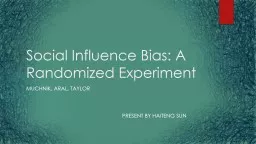

Muchnik Aral Taylor Present by Haiteng Sun Introduction our society is increasingly relying on the digitized aggregated opinions of others to make our own decision Question ID: 532192
Download Presentation The PPT/PDF document "Social Influence Bias: A Randomized Expe..." is the property of its rightful owner. Permission is granted to download and print the materials on this web site for personal, non-commercial use only, and to display it on your personal computer provided you do not modify the materials and that you retain all copyright notices contained in the materials. By downloading content from our website, you accept the terms of this agreement.
Slide1
Social Influence Bias: A Randomized Experiment
Muchnik
, Aral,
Taylor
Present by
Haiteng
SunSlide2
Introduction
our society is increasingly relying on the digitized, aggregated opinions of others to make our own
decisionSlide3
Question?
D
o
they produce useful, unbiased, aggregate information about the quality of the item being rated?Slide4
Herding Effects
Herding Behavior: describes
how individuals in a group can act collectively without centralized direction
.
Social influence on individuals’ perceptions of quality and value could create herding effects that lead to suboptimal market outcomes
rich-get-richer
A
group think
mentalitySlide5
Experiment Design
A large-scale randomized experiment to quantify the effects of social influence on users’ ratings and discourse on a social news aggregation web site.
Step 1: writing comments
Step 2: others
“up-vote” or “down-vote” these
comments
aggregate current
rating=#
of
up-votes - #
of down-votesthe data provide a unique opportunity to comprehensively study social influence bias in rating behaviorSlide6
Experiment
Data: 101,281 comments,
over 5
months
Three Treatments:
Up-treated (4049): +1 rating
Down-treated (1942): -1 rating
The experiment comments were
viewed more than 10 million times and rated 308,515 times by subsequent users.Slide7
Result
Up-treated: 5.13
%
Down-treated:
0.82%
Users did not tend to correct the upward
manipulation
Negative social influence inspired users to correct manipulated
ratings (down-votes
1.4%
)Slide8
Result: Control Comments
Positive
herding
effects:
Politics
culture
and
society
businessSlide9
Result: “Friends” V.S. “Enemies
”Slide10
Result: DiscourseSlide11
Other Findings
proportion of
positive (or negative) votes
Changing opinions about comment quality
F
our subgroup:
Positivity
The commenters
’
quality
T
he
frequency with which a rater rated a particular
commenter
W
hether
raters were friends or enemies with commentersSlide12
Other FindingsSlide13
Conclusion
positive social influence increased the likelihood of positive
ratings
negative social influence inspired users to correct manipulated ratingsSlide14
Thanks